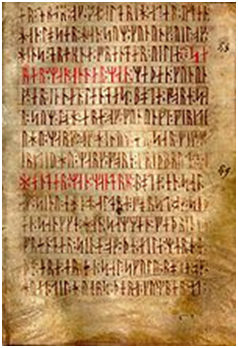Did you know that Bluetooth was named after
our Viking ancestor found in the LITTLE Family Tree?
The Bluetooth technology
design was named in 1997 after a Danish king, Harald “Bluetooth”, based on an
analogy that the technology would unite devices the way Harald Bluetooth united
the tribes of Denmark into a single kingdom. The Bluetooth logo consists of his
initials, H (ᚼ) and B (ᛒ) from and an alphabet of 16 characters from
the period. The alphabet is a runic alphabet called the “Younger Futhark”, and the
Bluetooth logo is a “bind rune”.
Who was Harald Bluetooth?
Harald "Bluetooth" Gormsson ruled as King of Denmark for
28 years (c.958–986), and ruled as king of Norway about 15 years in the 970’s. He introduced Christianity to Denmark and
consolidated his rule over most of Jutland and Zealand. He was the
son of King Gorm the Old and of Thyra Dannebod.
It seems Harald Bluetooth is well regarded among the Danes in
Denmark. 2 massive runestones were raised (carved with runic letters and
positioned) by he and his father that are national treasures. The two huge
rocks are located in the town of Jelling in Denmark and are commonly known as “Jelling
Stones”.
Large life-sized replicas of Harald Bluetooth’s stone are located
in many parts of the world. One was specially made for the Denmark exhibit in
the Panama International Exhibition in San Francisco in 1915. The exhibit
celebrated the completion of the Panama Canal only 9 years after the
devastating earthquake and fire of 1906, helping the city get back on its feet.
Runic Alphabet
Runestones and Jelling stones
A runestone is typically a raised stone with a runic (Viking alphabet prior to Latin) inscription. The tradition began in the 4th century and lasted into the 12th century, but most of the runestones date from the late Viking Age. Most runestones are located in Scandinavia, but there are also scattered runestones in locations that were visited by Norsemen during the Viking Age. Runestones are often memorials to dead men. Runestones were usually brightly colored when erected, though no longer evident as the color has worn off.
The Jelling stones are massive
carved runestones, from the 10th century, found at the town of Jelling in Denmark.
The older of the two Jelling stones was raised by
King Gorm
the Old in memory of his
wife Thyra. The larger of the two stones was raised by King
Gorm's son, Harald Bluetooth, in memory of his parents, celebrating his conquest
of Denmark and Norway, and his conversion of the Danes to Christianity. The runic inscriptions on these stones are considered the best known in
Denmark. In 1994, the stones, in addition to the burial mounds and small
church nearby, were inscribed on the UNESCO World Heritage List as an
unparalleled example of both pagan and Christian Nordic culture. The stones
are strongly identified with the creation of Denmark as a nation state. The
larger stone explicitly mentions the conversion of Denmark from Norse paganism and the
process of Christianization, alongside a depiction of the crucified Christ; it is
therefore popularly dubbed "Denmark's baptismal certificate”, an
expression coined by an art historian in the 1930s.
Runestones were originally colored similar to this copy in the Viking Exhibition in the National Museum of Denmark.
What is the Curmsun Disc?
The Curmsun Disc is a concave gold
disc, dated to the 10th to 12th century, that gained
scholarly attention in 2014 after an 11-year-old Polish girl in Sweden showed
it to her history teacher. The disc did not appear to be made of gold so it was
placed in a box with old buttons.
The disk weighs .890 oz and has a diameter of 1.8 in.
The Danish Viking king Harald
Bluetooth is mentioned in the inscription of the disc.
So when you see the Bluetooth logo or operate a wireless Bluetooth device like your wireless speakers or earbuds, you can say that it was named after your ancestor.
To find out more:
The rune stones - Jellingprojektet (natmus.dk)
Most information from Wikipedia and the National
Museum of Denmark.







